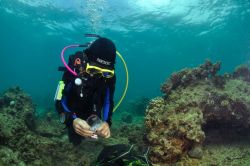
Abstract:
In the marine environment, macroalgae face changing environmental conditions and some species are known for their high capacity to adapt to the new factors of their ecological niche. Some macroalgal metabolites play diverse ecological functions and belong to the adaptive traits of such species. Because algal metabolites are involved in many processes that shape marine biodiversity, understanding their sources of variation and regulation is therefore of utmost relevance. This work aims at exploring the possible sources of metabolic variations with time and space of four common algal species from the genus Lobophora(Dictyotales, Phaeophyceae) in the New Caledonian lagoon using a UHPLC-HRMS metabolomic fingerprinting approach. While inter-specific differences dominated, a high variability of the metabolome was noticed for each species when changing their natural habitats and types of substrates. Fatty acids derivatives and polyolefins were identified as chemomarkers of these changing conditions. The four seaweeds metabolome also displayed monthly variations over the 13-months survey and a significant correlation was made with sea surface temperature and salinity. This study highlights a relative plasticity for the metabolome of Lobophora species.
A lire ici: https://www.nature.com/articles/s41598-018-38177-z